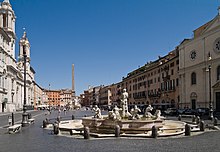Town square
![]()
This article describes an open space in an urban area. For other uses, see Square (disambiguation).
![]()
Schmuckplatz is a redirect to this article. For other meanings, see Schmuckplatz (disambiguation).
In the context of urban development, a square or town square is an open area in cities that is usually surrounded by buildings. Squares are often focal points of public life in the city. They are therefore the central theme and spatial element of urban design.
Central squares are the "parlour" of many cities and represent the city rulers or citizens. They are therefore usually particularly elaborately designed. Important public buildings such as town halls and churches are often located in central squares. The surrounding buildings have magnificent display facades. The square itself is decorated with monuments and fountains, the flooring often consists of valuable materials.
Squares are named in the respective national language, e.g. Square (English), Place (French), Piazza (Italian) or Plaza (Spanish).

Piazza Navona, Rome
Etymology
The word place goes back via Middle High German platz, plaz and Old French place to Vulgar Latin and Latin platea "wide street", "square". This in turn derives from Ancient Greek πλατεία plateia, a contraction from πλατεία οδός plateia hodós "broad street". The starting point is the Greek adjective πλατύς platýs "flat", "wide".
History
As long as there have been cities, there have also been central places where people gathered and traded. In ancient Greece, the agora was a meeting place for citizens surrounded by porticoes, lined with temples and decorated with monuments. In Roman architecture, the forum took over this function. Squares are also found in the orthogonal street grid of Roman military camps.
Town hall squares are found in all medieval town layouts, usually in the centre of the walled town. Roads lead from the city gates to this central square. An example is the Rynek Główny in Kraków, which is reached via the Royal Way. Sometimes buildings define the square with their narrow side, sometimes with their long side; sometimes the dominant buildings stand in the middle of the square. However, typical of medieval urban architecture are also sequences of squares or square systems, i.e. irregularly designed sequences of squares connected by streets, sometimes with a special function (cattle or fish market, cathedral or church square, etc.), adapted to an uneven topography. This creates structures of bodies and spaces that offer varied perspectives and surprising views of church towers and facades, for example. Examples of square systems or sequences are Bremen, Görlitz, Munich, Münster, Salzburg as well as many Italian cities such as Modena or Perugia.
In the Renaissance and Baroque periods, squares became more elaborate, refined and symmetrical. They were now planned by famous architects and laid out with reference to the layout of the city. Visual axes and perspective distortions played an important role, for example in Michelangelo's Capitol Square or Gian Lorenzo Bernini's St. Peter's Square in Rome.
Common to all traditional European plaza designs, according to Camillo Sitte, was the cohesiveness resulting from the relationship between buildings, facades, forecourts, plaza, and transitions between interior and exterior spaces. Drawing on 297 European case studies, he found that squares were always oriented toward a prominent building and that, at least when looking toward that building, the eye was not led beyond the perimeter development. Streets never entered this field of vision in such a way as to form a visual axis. For him, it is precisely this unity that constitutes the quality of historic squares. In contrast to this, he sees squares in the block development, which are only kept free areas because of the continuous street alignments at the edge and the intersections at the corners.
Since the increase in individual traffic, squares have become increasingly important as traffic hubs. A well-known example is the Place de la Concorde in Paris, which was created as the "Royal Square" and is now dominated by traffic.
The largest square is often called Tian'anmen Square in Beijing. It has an area of 39.6 ha.
Nowadays, urban planners, landscape architects, architects, traffic planners and artists deal with the design of squares.

Bremen: The medieval square system with market (15), Domshof (2), Domsheide (right o. no.) and Unser Lieben Frauen Kirchhof (12) (Matthäus Merian, 1653).
Search within the encyclopedia